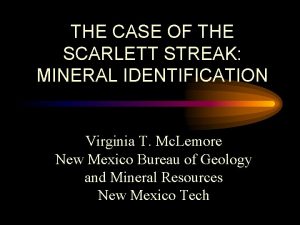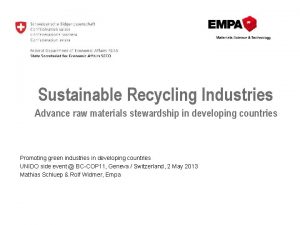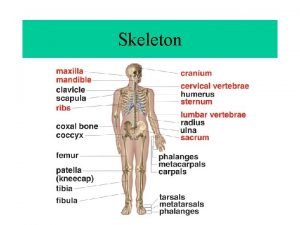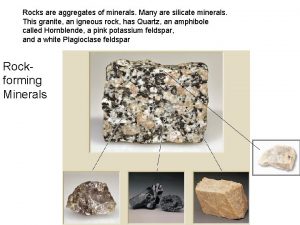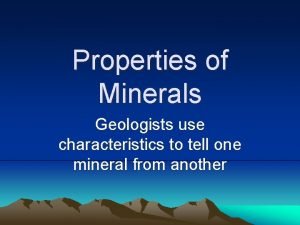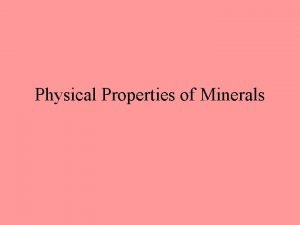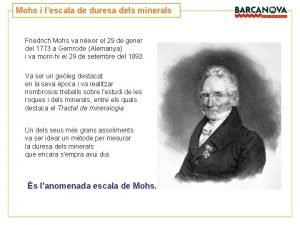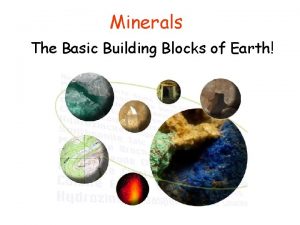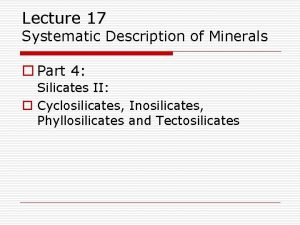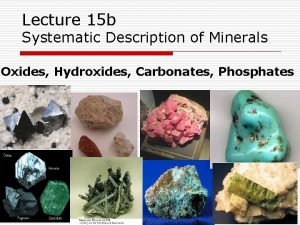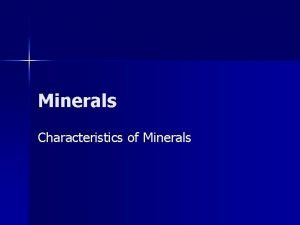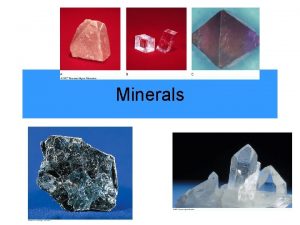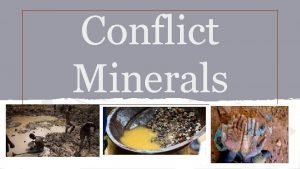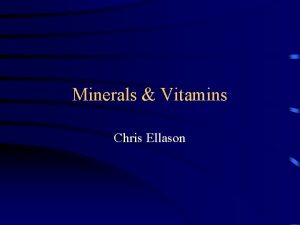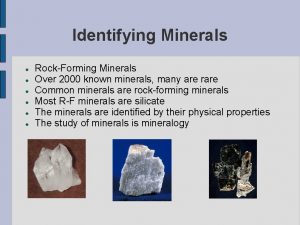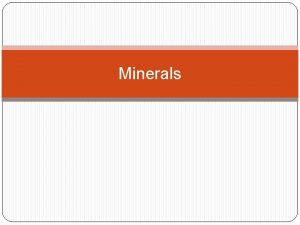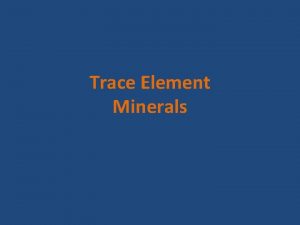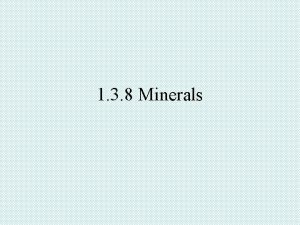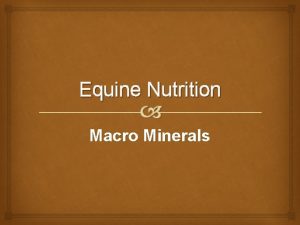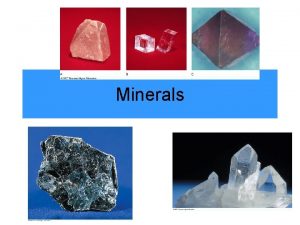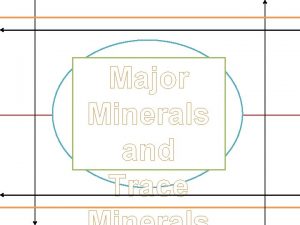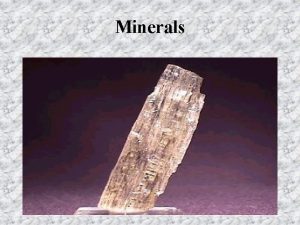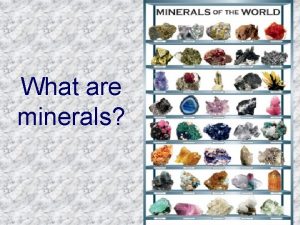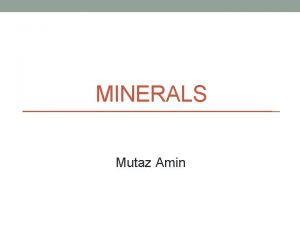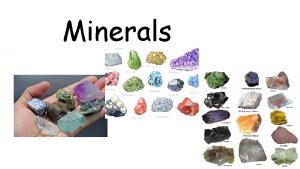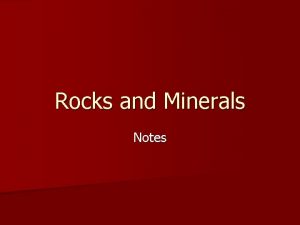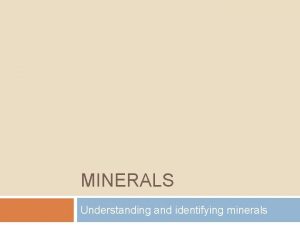Pyrope Lecture 16 Systematic Description of Minerals Part





![Role of Al in Silicate Minerals Al+3 may occur in tetrahedral [4] (substituting for Role of Al in Silicate Minerals Al+3 may occur in tetrahedral [4] (substituting for](https://slidetodoc.com/presentation_image/350833ccfc75582be694ee2d32133a41/image-6.jpg)



















- Slides: 25

Pyrope Lecture 16 Systematic Description of Minerals Part 3: Silicates I: Introduction to Silicates, Nesosilicates, and Sorosilicates

Predominance of Silicate Minerals in the Earth’s Crust CRUST MOSTLY Oxygen O and Silico. N Si 27% of all known minerals are silicates 40% of common minerals are silicates >90% minerals in the earth’s crust are silicates

Silicon Tetrahedra – the basic building block of silicate minerals The Si-O bond – 50% covalent, 50% ionic Electrostatic Valence (e. v. , measure of bond strength)=Z/CN=4/4 =1 Each tetrahedral oxygen shares a -1 charge with the tetrahedral silicon and has an extra -1 charge to share with another cation Four (4) oxygens in each tetrahedron, so total charge -4


Polymerization of Silicon Tetrahedra Oxygens can share electrons with two silicons Adjacent silicon tetrahedra can share corners, but because of the high repulsive charge of Si+4 cations, they will not share edges or faces. These shared corners are called bridging oxygens.
![Role of Al in Silicate Minerals Al3 may occur in tetrahedral 4 substituting for Role of Al in Silicate Minerals Al+3 may occur in tetrahedral [4] (substituting for](https://slidetodoc.com/presentation_image/350833ccfc75582be694ee2d32133a41/image-6.jpg)
Role of Al in Silicate Minerals Al+3 may occur in tetrahedral [4] (substituting for Si+4) or octahedral [6] coordination Ionic radius of Al+3 = 0. 39Å (4 -fold) (Si+4=0. 26Å) = 0. 54Å (6 -fold) Ionic Al: O Radius Ratio (4 -fold) =0. 39/1. 36=0. 286 (Upper limit of tetrahedral coordination RR=0. 225) Ionic Al: O Radius Ratio (6 -fold) = 0. 388 (Upper limit of octahedral coordination RR=0. 414) Bond strength: e. v. = 3/4 for Al+3 in tetrahedral coord. = 3/6=1/2 in octahedral coord.

O-coordination and Bond Strength of Other Common Cations in Silicate Minerals Electostatic Valence w/ O-2 big medium small 1/8 - 1/12 Weak 1/6 - 1/8 1/3 – 1/4 2/6 = 1/3 3/6 = 1/2 4/6 = 2/3 3/6 = 1/2 3/4 4/4 = 1 Strong Note size trend for all, dual coordination for Al+3 , and silicate cation labels XYZ

Silicate Mineral Classification (based on arrangement of Si. O 4 tetrahedra)

Silicate Mineral Classification (based on arrangement of Si. O 4 tetrahedra) Nesosilicates Inosilicates Sorosilicates Inosilicates Cyclosilicates Phyllosilicates Tectosilicates

Nesosilicates (independent tetrahedra) • X 2(Si. O 4) Unit Composition X often +2 valence • Isolated, but tightly packed (Si. O 4)4 - tetrahedra • Forms silicate minerals with: High density and hardness Equi-dimensional habits Poor cleavage • Low degree of Al substitution with Si Olivine X = Mg+2 or Fe+2

Common Nesosilicates: Olivine (Mg, Fe)2 Si. O 4 High-T igneous mineral, common in mafic and ultramafic rocks; commonly alters to serpentine Vitreous olive green (Mg) to black (Fe) Equigranular to prismatic habit; poor cleavage Optics: Colorless, biaxial (positive if Mg++, negative if Fe++), mod. high relief (n~1. 7), high 2 V, ~. 05 (2 nd order IF colors) Complete solid solution between Mg and Fe

Common Nesosilicates: Zircon is Zr. Si. O 4. Hafnium is almost always present in quantities ranging from 1 to 4%. The crystal structure of zircon is tetragonal. The natural color of zircon varies between colorless, yellow-golden, red, brown, and green. Zircon usually contains radioactive Uranium and Thorium, and is frequently used to date plutonic rocks. In Petrology we will visit the Bemco Mining prospect in Cranberry Lake, NJ, on the National Registry as a site for strategic elements Uranium and Thorium in Zircon

Common Nesosilicates: Garnet (Mg, Fe, Mn, Ca)3(Fe 3+, Cr, Al)2 Si 3 O 12 As mod-T metamorphic mineral formed from Al-rich source rocks and Grossular ultramafic mantle rocks (eclogites) Equigranular, euhderal to subhedral habit; poor cleavage Optics: Colorless, isotropic, high relief (n~1. 7 -1. 9) Complex solid solution with the following end-member compositions and their characteristic colors: Pyrope Mg 3 Al 2 Si 3 O 12 – deep red to black Almandine Fe 3 Al 2 Si 3 O 12 – deep brownish red Spessartine Mn 3 Al 2 Si 3 O 12 – brownish red to black Almandine Grossular Ca 3 Al 2 Si 3 O 12 – yellow-green to brown Andradite Ca 3 Fe 2 Si 3 O 12 – variable-yellow, green, brown, black Uvarovite Ca 3 Cr 2 Si 3 O 12 – emerald green Andradite

B-site Aluminum octahedral Garnet A 3 B 2 Si 3 O 12 Usually B is Aluminum, A divalent Almandine Fe 3 Al 2 Si 3 O 12 A-site Fe++, Mg++, Ca++, Mn++ in distorted octahedra

Common Nesosilicates: The Aluminosilicates Kyanite, Sillimanite, Andalusite Al 2 Si. O 5 Moderate to high grade metamorphic minerals formed from Al-rich source rocks Al in octahedral or a mix of octahedral to tetrahedral sites. Kyanite – Vitreous bluish bladed tablets w/ single perfect cleavage; H: 5 -7 Sillimanite – Vitreous brown to green clustered prisms w/ single cleavage dir. Andalusite – Vitreous flesh-red, reddish brown square prisms; H: 7. 5 Penet. twins, forming a cross

Common Nesosilicates: Staurolite Fe 2 Al 9 O 6(Si. O 4)4(O, OH)2 Moderate to high grade metamorphic mineral formed from Al-rich source rocks Resinous to vitreous (dull when altered) reddish-brown to brownish black 6 sided prisms; commonly forms penetrating twins Optics: Biaxial(-), yellow pleochroic, high relief (n~1. 75), 2 V=82°-88°

Common Nesosilicates: Sphene (Titanite) Ca. Ti. O(Si. O 4) Common accessory mineral in felsic igneous rocks and in some metamorphic rocks Resinous to adamantine, gray, brown, green, yellow or black lens crystals; distinct diamond-shaped cleavage; H: 5 -5. 5 Optics: Biaxial(+), yellow pleochroic, very high relief (n~2. 0), 2 V=27°, = 0. 13

Common Nesosilicates: Topaz Al 2 Si. O 4(F, OH)2, Orthorhombic prismatic terminated by pyramidal and other faces, the basal pinacoid often being present. Perfect basal {001} cleavage The fracture conchoidal to uneven. Hardness 8, specific gravity 3. 4– 3. 6, and a vitreous luster. Color wine or straw-yellow. They may also be white, gray, green, blue, pink, or reddish-yellow and transparent or translucent.

Sorosilicates (double tetrahedra) (Si 2 O 7)-6 • Double silicon tetrahedra linked by one bridging oxygen • Sorosilicates commonly also contain independent silica tetrahedra (Si. O 4)-4 • Typically monoclinic symmetry Epidote Si 2 O 7

Common Sorosilicates: Epidote Group Zoisite/Clinozoisite – Ca. Al 3 O(Si. O 4)(Si 2 O 7)(OH) Epidote – Ca 2(Fe, Al)Al 2 O(Si. O 4)(Si 2 O 7)(OH) Common accessory and alteration mineral in igneous rocks and is a common phase in various grades of metamorphic rocks Zoisite – Orthorhombic; Clinozoisite and Epidote – Monoclinic Physical Properties: prismatic vitreous crystals to very fine resinous massive granules; H: 6 -7 Zoisite: Gray, greenish brown (pink-thulite) Clinozoisite: Gray, pale yellow, pale green, colorless Epidote: Pistachio green to yellow green, Optics: Zoisite: Biaxial(+), high relief (n~1. 7), 2 V=0 -70°, ~ 0. 005 Epidote Clinozoisite: Biaxial(+), high relief (n~1. 7), 2 V=14 -90°, ~0. 010 Epidote: Biaxial(-), high relief (n~1. 75), 2 V=74 -90°, ~0. 015 -. 051, green-yellow pleochroic;

Common Sorosilicate: Vesuvianite (aka Idocrase) Ca 10(Mg, Fe)2 Al 4(Si. O 4)5(Si 2 O 7)2(OH)4 Common mineral found in thermally metamorphosed limestone with garnet, wollastonite (Ca-pyroxene), and diopside (Mg-Ca-pyroxene) Vitreous to resinous, green to brown, columnar to granular crystals, commonly striated parallel to columns; H: 6. 5

Common Sorosilicates: Hemimorphite, is a sorosilicate, Zn 4(Si 2 O 7)(OH)2. H 2 O from the upper parts of zinc and lead ores, chiefly associated with Smithsonite. Hemimorphite most frequently occurs as the product of the oxidation of the upper parts of Sphalerite (Zn. S) bearing ore bodies, accompanied by other secondary minerals which form the so-called iron cap or gossan. Hemimorphite is an important ore of zinc and contains up to 54. 2% of the metal. The first guide mentioned this origin during the Mine Field Trip.

2011 Field Trip

Looking at the Ore Body

In the Mine
 What is a technical description
What is a technical description 01:640:244 lecture notes - lecture 15: plat, idah, farad
01:640:244 lecture notes - lecture 15: plat, idah, farad Peas description for part picking robot
Peas description for part picking robot Part picking robot peas
Part picking robot peas Peas description for part-picking robot
Peas description for part-picking robot Peas for internet shopping agent
Peas for internet shopping agent Simple reflex agent
Simple reflex agent The environment for “chess with clock” is
The environment for “chess with clock” is Part part whole addition
Part part whole addition Unit ratio definition
Unit ratio definition Part part whole
Part part whole Components of a bar
Components of a bar The phase of the moon you see depends on ______.
The phase of the moon you see depends on ______. Two way anova minitab 17
Two way anova minitab 17 Streak of minerals
Streak of minerals Conflict minerals
Conflict minerals Storage of minerals
Storage of minerals Semi circular bunds
Semi circular bunds Solid rock cycles
Solid rock cycles Rocks are aggregates of minerals
Rocks are aggregates of minerals Rocks and minerals song
Rocks and minerals song Rock cycle
Rock cycle What does cleavage mean in minerals
What does cleavage mean in minerals Properties of minerals
Properties of minerals Duresa minerals
Duresa minerals The building block of the silicate minerals is _____.
The building block of the silicate minerals is _____.














